Terrarium plants are a surprisingly broad topic.
I don’t blame you if you’re feeling overwhelmed with the choices.
After all, there are countless ways to build a terrarium, and the type you choose will dictate your available plant choices.
Tropical, arid, open, closed, low light, full sun – you name it, we’ve got it!
In this guide, I’ll walk you through the process of selecting the perfect terrarium plants for your setup. So whatever you want to build, you’ve got the right plants.
Ready? Let’s get started.
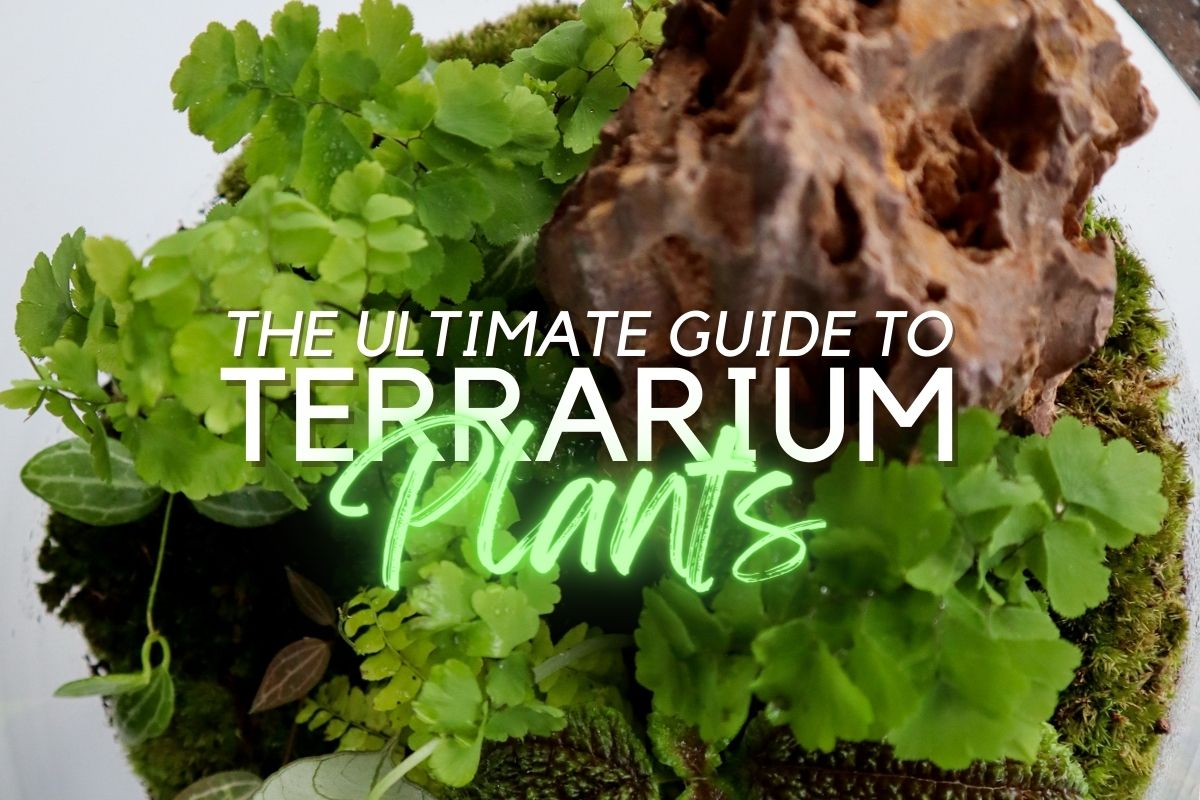
Terrarium Tribe is reader-supported. When you purchase through links on our site, we may earn an affiliate commission (at no further cost to you). 💜
Terrarium Plants Ideas – Where to Start?
Okay, let’s begin with the fundamental question.
Do you want plants for an open terrarium or a closed terrarium?
Everything else naturally follows from this critical distinction. I’m afraid there’s no mixing and matching between these two very different groups of plants.
So, I’ll break each one down, along with a few terrarium plant ideas for each.
- Closed terrarium plants are tropical plant species that thrive in the hot and humid conditions of a sealed terrarium, e.g., miniature ferns, tropical vines, and orchids.
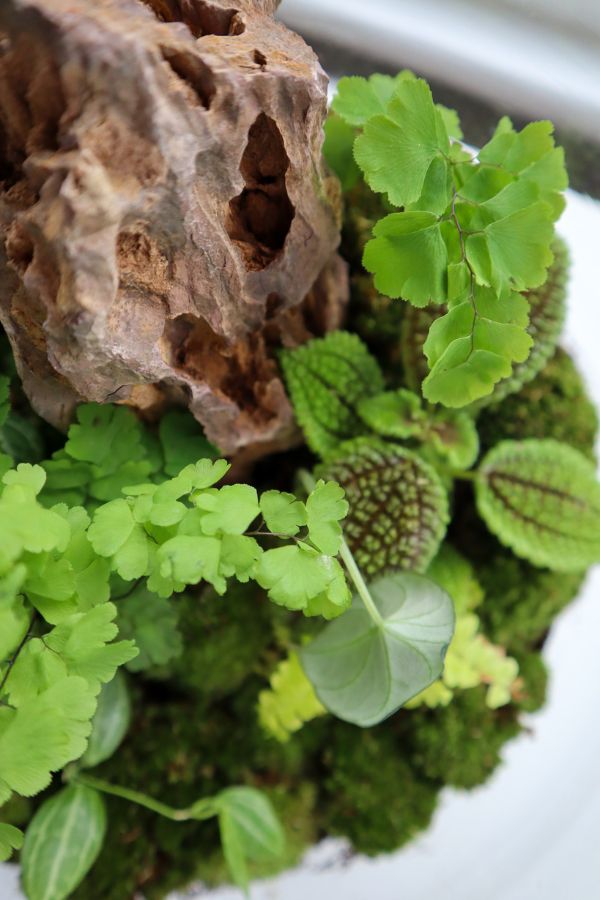
- Open terrarium plants are typically arid species that enjoy low moisture and humidity environments with good airflow, e.g., mini cacti and succulents. However, smaller houseplant species can work too (separately from arid plants).
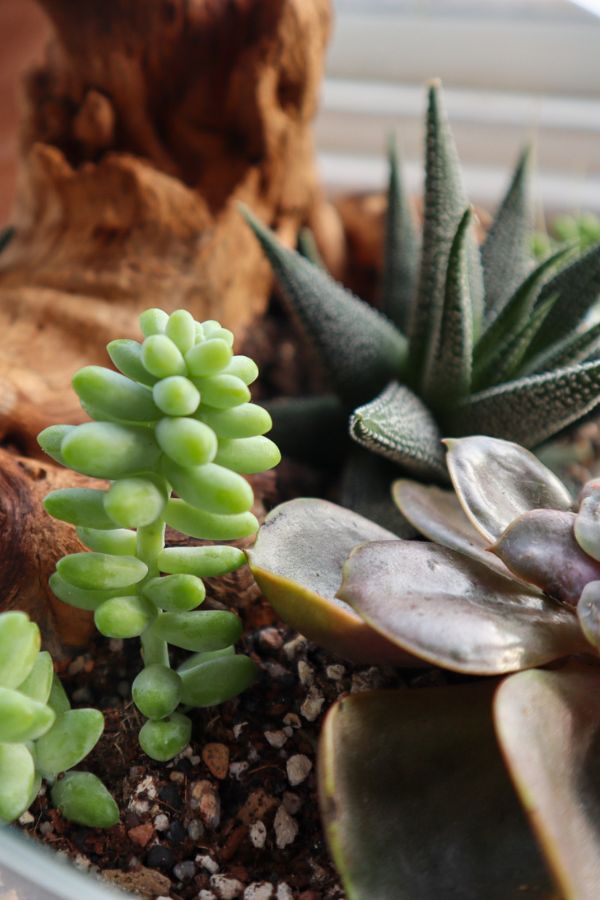
As you might imagine, tropical and arid plants go together like chalk and cheese. You’ll never have a good time trying to combine them.
One cannot thrive in the same conditions as the other.
So that’s why we decide the kinds of plants and terrarium we want upfront. Trust me; it makes the whole process much easier.
With that out of the way, we’ll deep dive into these different types of terrarium plants (and, later, where to buy them online).
Starting with the classic closed terrarium.
Closed Terrarium Plants
A closed terrarium is essentially a miniature rainforest in a glass container.
It’s the authentic terrarium experience in form and function. Thanks to a functional water cycle, microclimate, and finely-tuned ecosystem, you can grow a whole world of exotic plants from the comfort of your home (albeit a small world).
So naturally, you’ll want small, humidity-loving, slow-growing tropical plant species.
These kinds of tropical understory plants also tend to be forgiving in low light, so that’s a bonus.
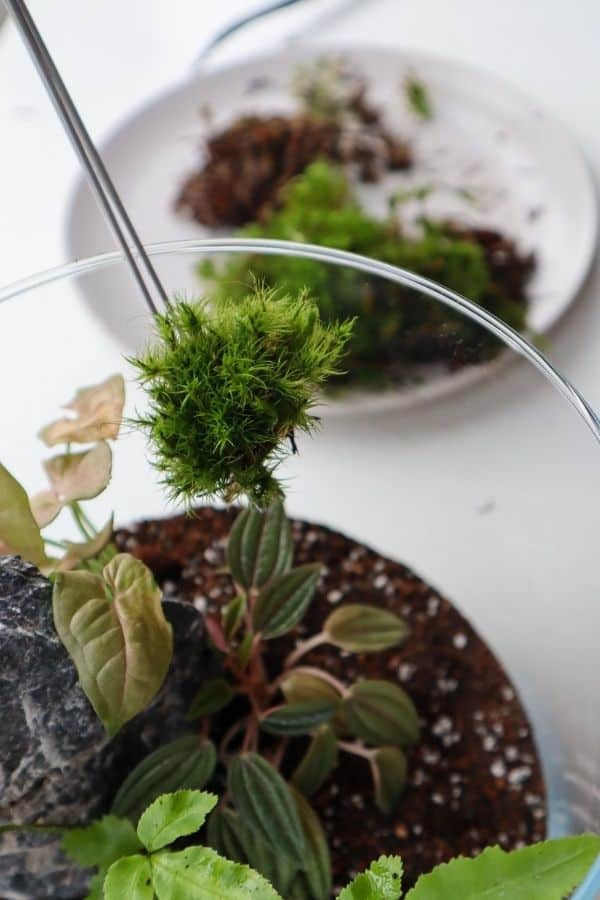
To achieve a natural-looking scene, you’ll need to choose plants from at least a few (preferably all) of the following closed terrarium plant categories.
After all, these are the best kinds of plants for terrariums:
- Ferns – Sword Ferns, Maidenhair Ferns, Button Fern.
- Foliage – Peperomia, Calathea, Begonia, Pilea, Jewel Orchids.
- Vines – Selaginella, Ficus pumila, Syngonium.
- Epiphytes – Tillandsia Air Plants, Neoregelia, Anubias.
- Moss – Cushion Moss, Mood Moss, Hypnum Moss.
Of course, how this looks is entirely up to you.
Want to highlight the ornate foliage of the Nerve Plant or the beautiful flowers of the African Violets? Sure! Prefer the wild growth of the Creeping Fig and Golden Clubmoss? Great! Want to recreate your favorite T-Rex scene from Jurassic Park… Just me?
Whatever your tastes in plants, ideas (and films), there’s a wide range of plants to choose from.
I’d also recommend choosing small-leafed plants where possible for your DIY projects. After all, you can easily trim stems and vines, but giant leaves, not so much (Monstera, I’m looking at you).
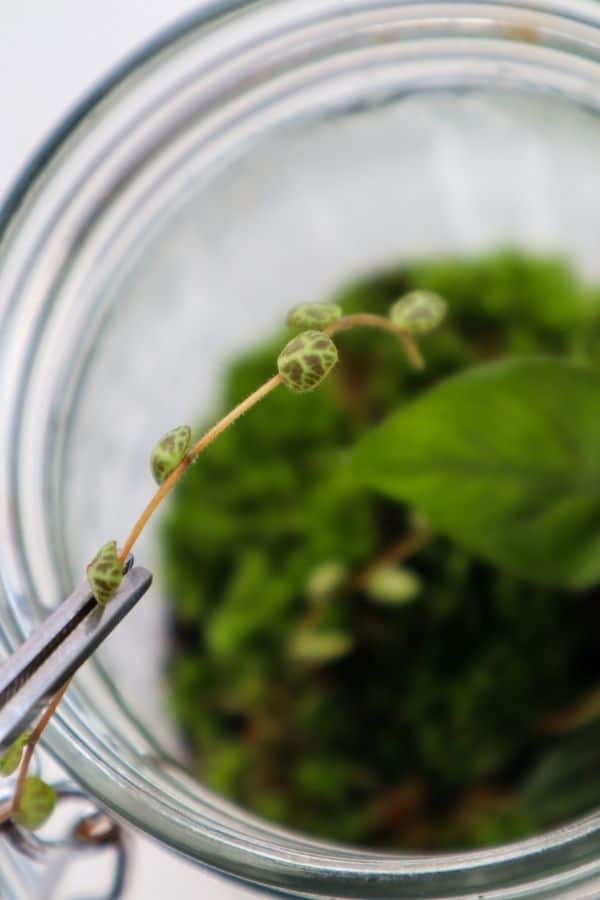
Besides, choosing smaller plants means you can fit more of them in.
Need more help choosing closed terrarium plants (and finding them for sale online?).
👉 Check out our Definitive Guide to Closed Terrarium Plants.
Small / Miniature Terrarium Plants
Honestly, finding small terrarium plants isn’t so hard.
It’s finding plants that start small and stay small that can be a challenge.
You’d be surprised how many of those perfectly petite plants at the garden center are just baby big plants! (Yes, I’ve made that mistake on several occasions).
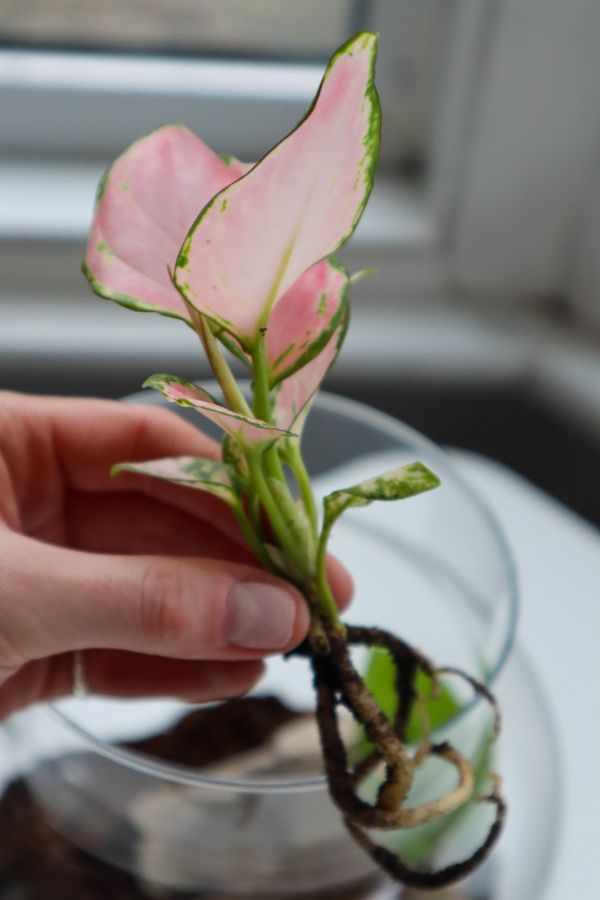
It’s not so much a problem for open terrariums. Still, it can get out of hand in our closed miniature gardens. Fully rooted plants do not come out without a fight, and things can get ugly…
Want some truly small terrarium plants? They come in a variety of forms:
- Dwarf varieties of large terrarium plants, e.g., the ‘Fluffy Ruffles’ Sword Fern.
- Jewel Orchids and Jewel Alocasia, e.g., the Lightning Jewel Orchid.
- Miniature vines, e.g., Peperomia prostrata and Pilea glauca.
- Miniature flowering plants, e.g., Begonia foliosa or Biophytum sensitivum.
All of these are fantastic small plant ideas for closed terrariums.
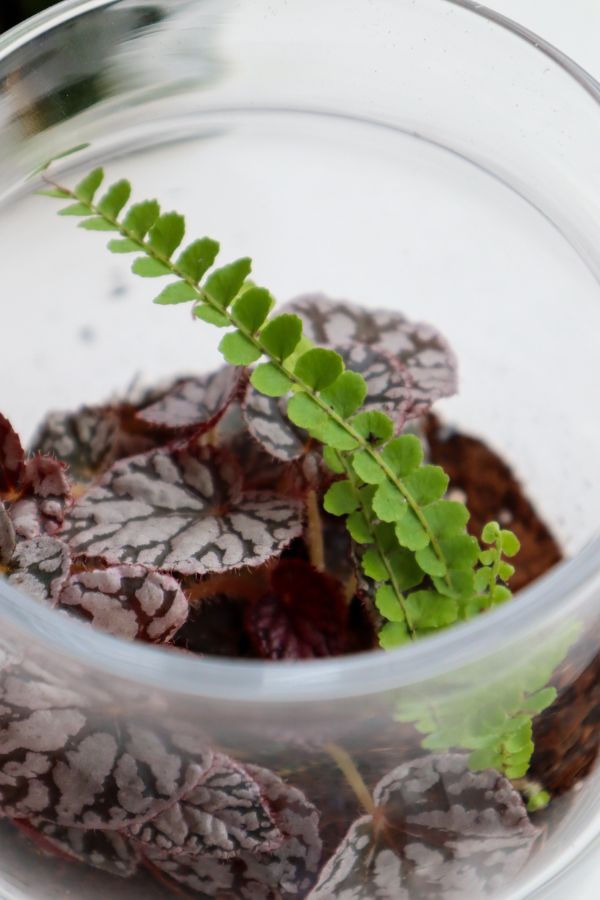
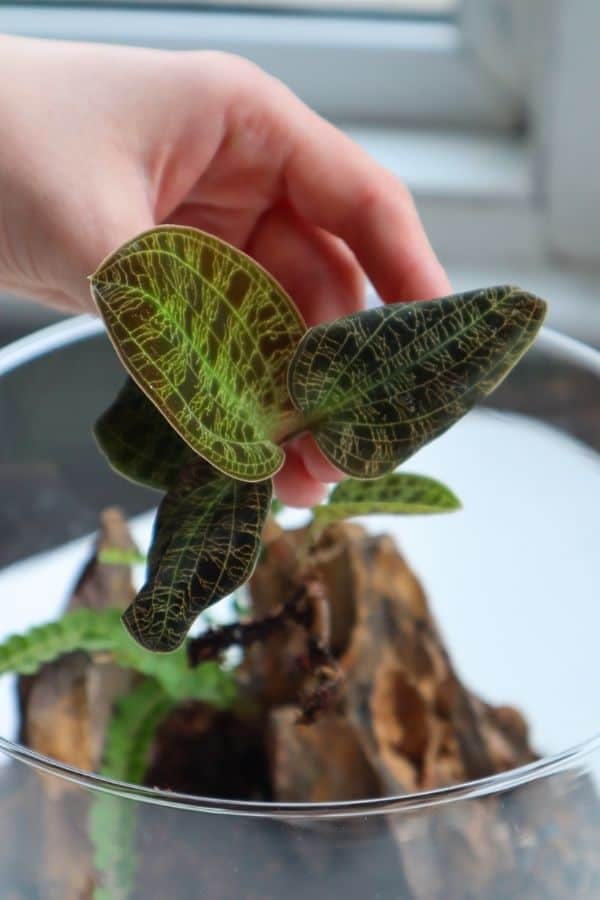
Just note that you typically won’t find these specialist terrarium plants very often in your local garden centers. Instead, you’re best off finding these for sale online.
👉 Check out our Top 10 Small Terrarium Plants (and where to buy them).
Terrarium Plants for Beginners
The ideal terrarium plants for beginners come in all shapes and sizes.
What they share is their adaptability, versatility, and ease of care.
Basically, they’re a range of plants almost guaranteed to thrive in a tropical closed terrarium (and look good doing it). Here are a few ideas to get you started:
- Nerve Plant – A true terrarium staple, the ornate foliage of the Fittonia is synonymous with modern terrariums. Though it can be a little dramatic when underwatered, it’s perfectly suited to tropical terrarium life.
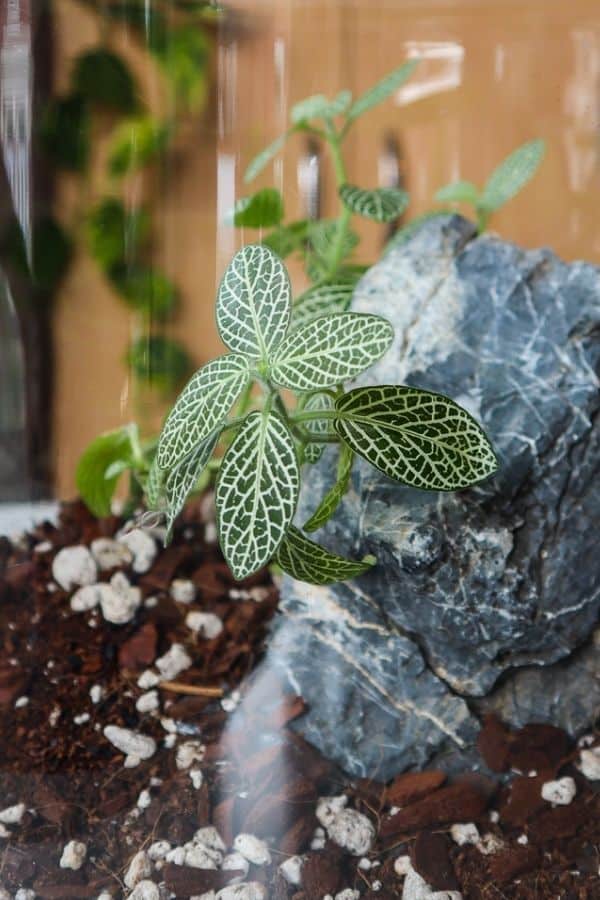
- Selaginella – Somewhere between a moss and a fern, Selaginella brings the best of both worlds to a terrarium. The green foliage of this creeping vine is full of texture and color, and it’ll quickly form a dense mat over any surface it can grow.
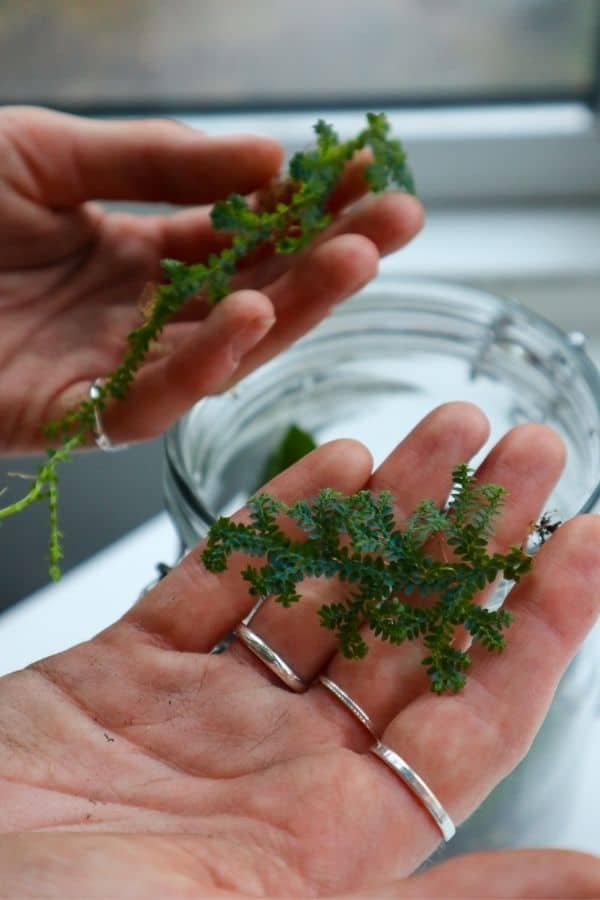
- Polka Dot Plant – These vivid speckled beauties are a great pop of color in any terrarium scene. They do great in warm temperatures and a humid environment, so they’re ideal terrarium plants.
- Ficus pumila – Nothing can stop this prolific plant from working its way around a terrarium. Just pop in a few cuttings and watch them go!
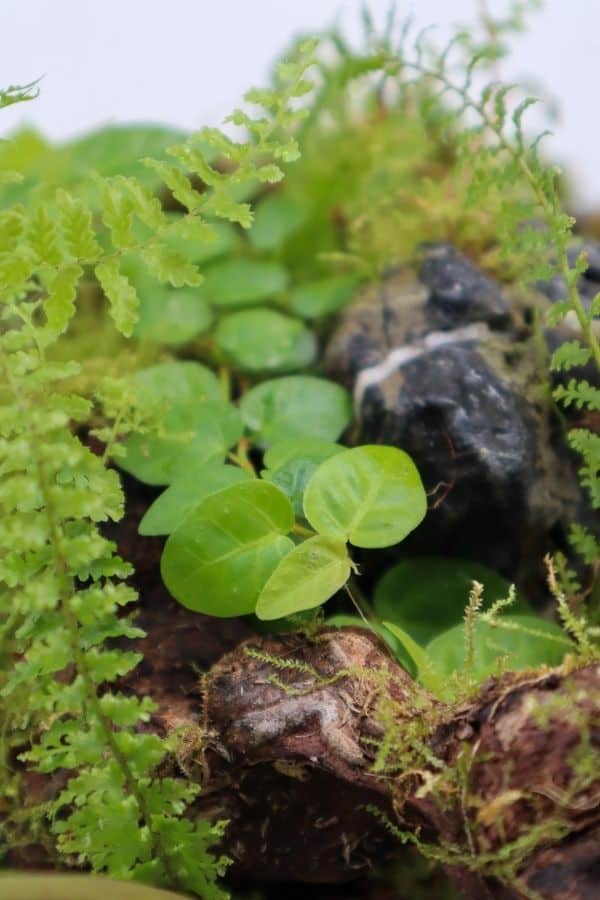
- Pilea – The Aluminum Plant and Friendship Plants are both great examples of miniature foliage plants that thrive in tropical conditions. Their bold, variegated leaves and vivid colors are simply stunning.
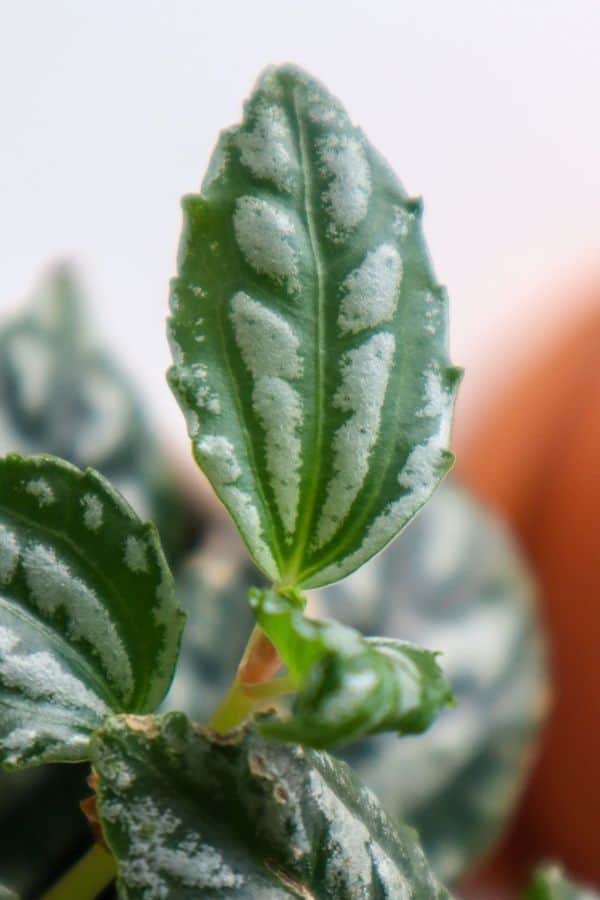
- Cushion Moss – This bouncy verdant moss is super easy to work with, helps you sculpt the scene to your desires, and loves the moist conditions of a closed terrarium (even though it’s technically a temperate moss).
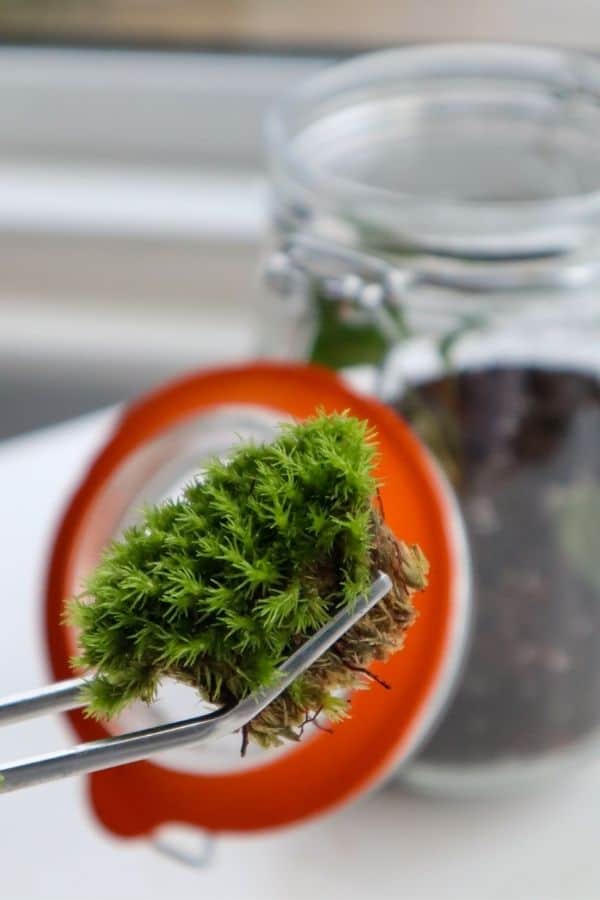
Just be mindful of other recommendations you may find for beginner terrarium plants for sale.
Honestly, despite what people say online, carnivorous plants are not beginner-friendly. At all.
Then you have the likes of Prayer Plants, which – while suited to humid conditions – are very temperamental and sensitive to low airflow. The same goes for Maidenhair ferns.
Need more inspiration? See our full list of top picks.
👉 Check out our Best Terrarium Plants for Beginners.
Next up, we’re switching gears and diving into open terrarium plants.
Open Terrarium Plants
Open terrariums are a modern take on the terrarium concept.
Without a lid/seal, they won’t trap moisture or humidity like a closed terrarium. So, instead of your typical tropical terrarium plants, they’re best for growing arid and low-humidity varieties.
You know, the kind that typically thrives on neglect?
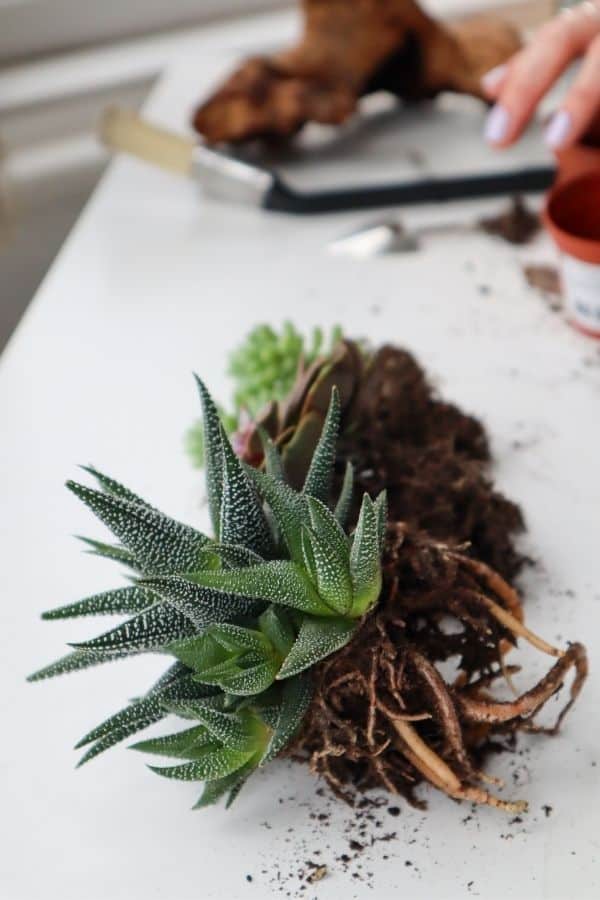
That said, the amount of different arid species for sale online is vast. They vary in care a little, but they all need full sun (low-light areas will not cut it) and good airflow.
I’d try to find smaller varieties if you can. Though these plants tend to grow slowly, some chunky numbers can get surprisingly big.
Here are some great ideas for arid open terrarium plants.
- Succulents – Echeveria, Haworthia, Sedum.
- Cacti – Hedgehog Cacti (Echinocereus), Gymnocalycium.
Despite the relative ease of care with arid plants, these kinds of open terrariums will need to use some unique materials and construction methods.
That’s because arid plants really can’t handle being wet for long.
Consistently moist soil is a surefire way to turn these plants into soggy mush. So, arid open terrarium layers and substrates must be well-optimized for drainage.
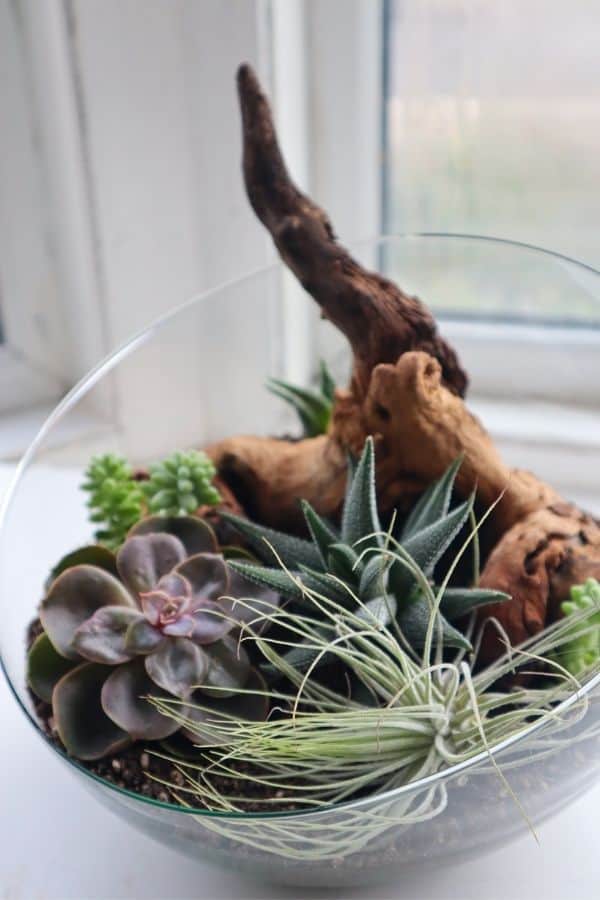
On the flip side, arid plants aren’t the only kinds of plants you can use. You can also think of open terrariums as artistic planters. In that, anything you can grow in the house can thrive in an open terrarium.
- Houseplants – Philodendron, English Ivy, Spider Plant.
- Air Plants – Tillandsia bulbosa or Tillandsia Ionantha.
Open terrariums provide a unique opportunity to grow (slightly) larger-leafed varieties or long vines that can trail beyond the barriers of the container. Just don’t combine tropical houseplants with arid plants – that rule still holds up.
Whereas Air Plants are just horticulture on easy mode!
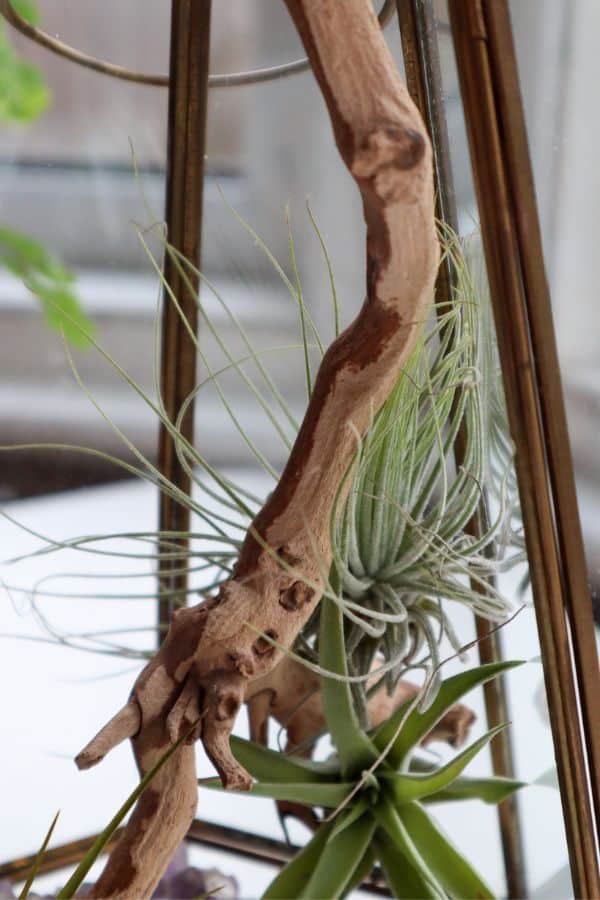
👉 Check out our Complete Guide to Open Terrariums.
Where to Find Terrarium Plants For Sale Online
Terrarium plants are a special breed.
Most indoor plant owners aren’t looking for small plants that require humid conditions.
Even the standard tropical plants for closed terrariums can be uncommon at your local houseplant store. So you may need to go further than searching for “terrarium plants near me.”
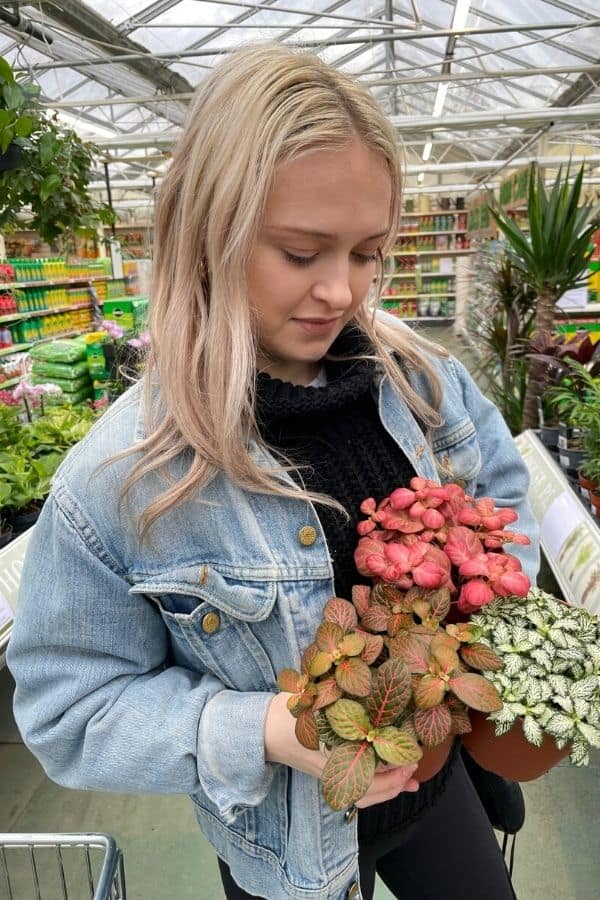
Knowing where to buy terrarium plants online is a huge help.
That’s why I look to Etsy both for my plant purchases (and for my ideas/inspiration).
From cheap and cheerful miniature ferns to rare exotic orchids – there’s an endless supply of tropical terrarium and vivarium plants.
Though we’re not selling plants (yet) on our online store, it’s worth checking out our other terrarium supplies!
What About a Terrarium Plants Kit?
Sometimes, finding a terrarium kit online can be an absolute lifesaver.
Getting the right amount of plants and materials for a single build can significantly reduce the cost, time investment, and potential waste.
Nobody wants to buy a large bag of river stones for one little mason jar terrarium, right?
So, the main types of adult terrarium kits tend to fall into three categories.
- Tropical terrarium kits – Usually a glass jar with drainage materials, substrate, and a variety of miniature plants and mosses. Hopefully, some basic tools too.
- Succulent terrarium kits – With an assortment of mini cacti and succulents plus a glass bowl or geometric container, these are a wonderful way to design a mini garden.
- Moss terrarium kits – The humble moss terrarium is a great way to get started in the hobby. Super simple and typically just a few inches tall, they’re great for kids.
You can find a variety of terrarium kits on Amazon, but I’d recommend you buy one from Etsy instead. They tend to be much higher quality, and you’re supporting independent creators.
Win-win.
👉 Check out our guide to the Best Terrarium Kits.
Terrarium Plants Care
Okay, for those of you who have reached this far (and now have some terrarium plants of your own), we’re finally onto the care section.
Hopefully, you’ve chosen well from our lists of suitable plant species!
I’ll be mostly talking about how to care for closed terrarium plants here with a wider view of caring for the plants as part of the ecosystem at large.
You can also check out our complete Terrarium Plants Care Guide for more help.
Then, I’ll finish by covering some open terrarium plant care too.
Lighting for Terrariums
Bright indirect light is the gold standard for terrariums.
It best represents the kind of dappled sunlight that our favorite tropical plants would find naturally on the rainforest floor.
The darker the green leaves, the more tolerant of low light the plants may be (due to increased concentrations of chlorophyll), but remember, “low light” does not mean “no light.”
Only a handful of truly low-light terrarium plants can handle full shade.
In the home, bright light still means you’d be able to read a book comfortably. Just keep these delicate plant types out of direct sunlight.
Of course, artificial light can help a lot here, too.
It’s much easier to provide lots of light safely with an LED grow light or fluorescent lighting vs. managing the ever-changing lighting conditions through the seasons and days.

How to Water a Terrarium
Watering a terrarium is all about maintaining a delicate balance.
Just enough moisture to keep your plants watered and the humidity up, but not so much that you waterlog the system. Unfortunately, root rot can quickly spell the end of any happy terrarium ecosystem.
When considering that a closed terrarium works by trapping moisture, you shouldn’t need to regularly water the plants inside.
So, what’s the easiest way to water a terrarium?
A few sprays from a spray bottle every couple of months is usually enough in a sealed terrarium.
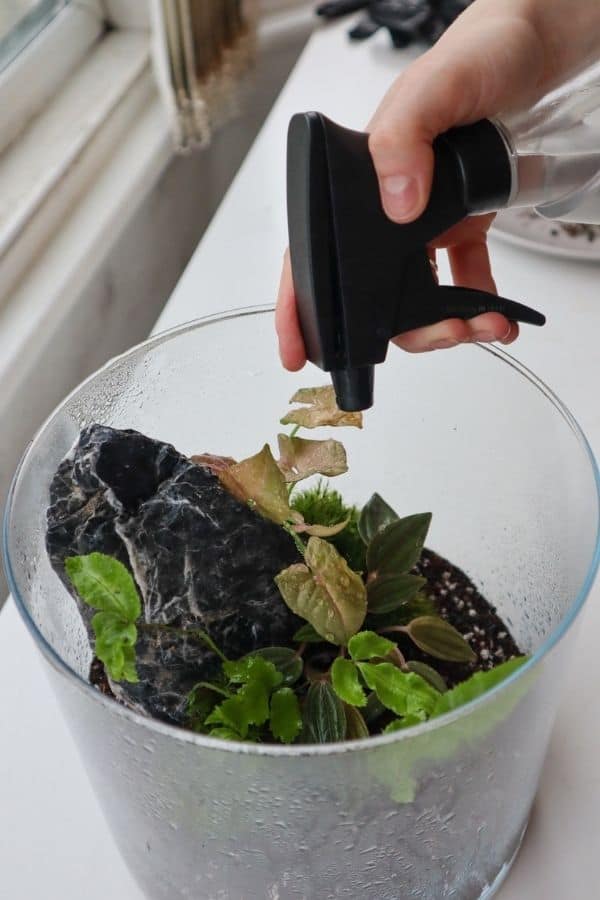
It’s all too easy to overdo it, so it’s best to only add a little at a time.
I find it’s especially easy to overdo it on terrariums with moss. Remember, the high humidity keeps them moist and happy long-term, not the misting!
How to Trim Terrarium Plants
An overgrown terrarium can lead to a variety of issues.
Competing for light, space, and nutrients can lead to unhealthy plants, stunted growth, and a dysfunctional terrarium.
So, it’s worth keeping on top of any quick growers.
Try pinching off stems at the top where possible to encourage thicker foliage growth. I’d recommend using curved aquascaping scissors for places you can’t reach with your hands (as these can get around a bit easier).
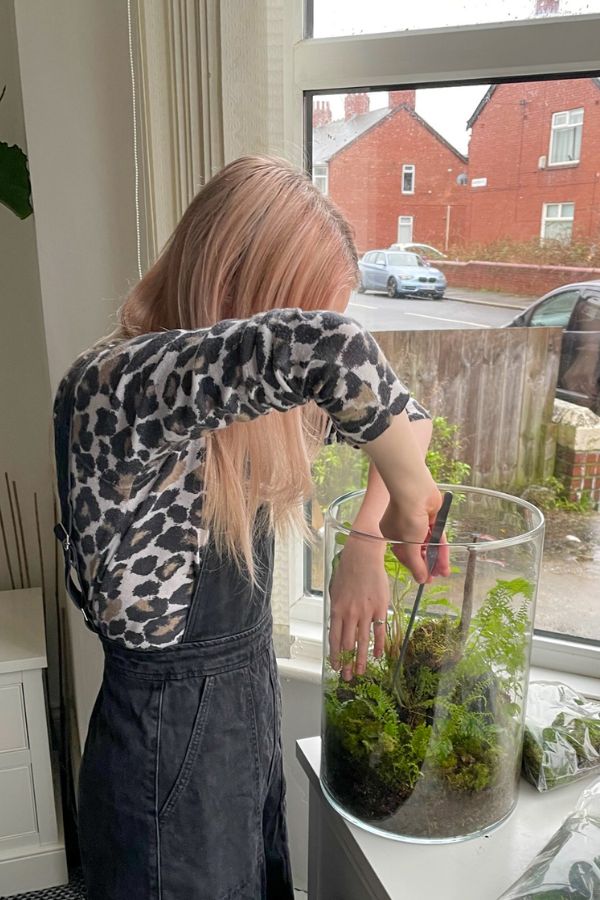
Of course, buying small, slow-growing plants is an ideal solution, too.
Open Terrarium Plants Care
Finally, we’re onto the arid varieties.
For both cacti and succulent terrarium care, direct sunlight is a must. They need plenty of hours in full sunlight to get their fill.
They also need consistently dry conditions, so be mindful of your watering and ensure you have a drainage layer and a well-draining substrate.
Remember, when you’d grow these as potted plants, they’d 100% have a drainage hole. So you need to do your best to recreate these conditions (sans hole).
That’s a Wrap!
Thanks for sticking with me on this wild journey through the world of terrarium plants!
We’ve covered just about every main plant type, but the list of individual terrarium plant species is vast (and ever-growing).
What’s your favorite tropical species? Let me know in the comments.
Next up, why not check out our beginner’s DIY Terrarium Guide?

Very well explained.Thank you so much for details.
Excellent article. Thanks so much for all the information throughout the site!
Esp. found the articles on mosses helpful.
And the photos are terrific!
Thanks
Kate